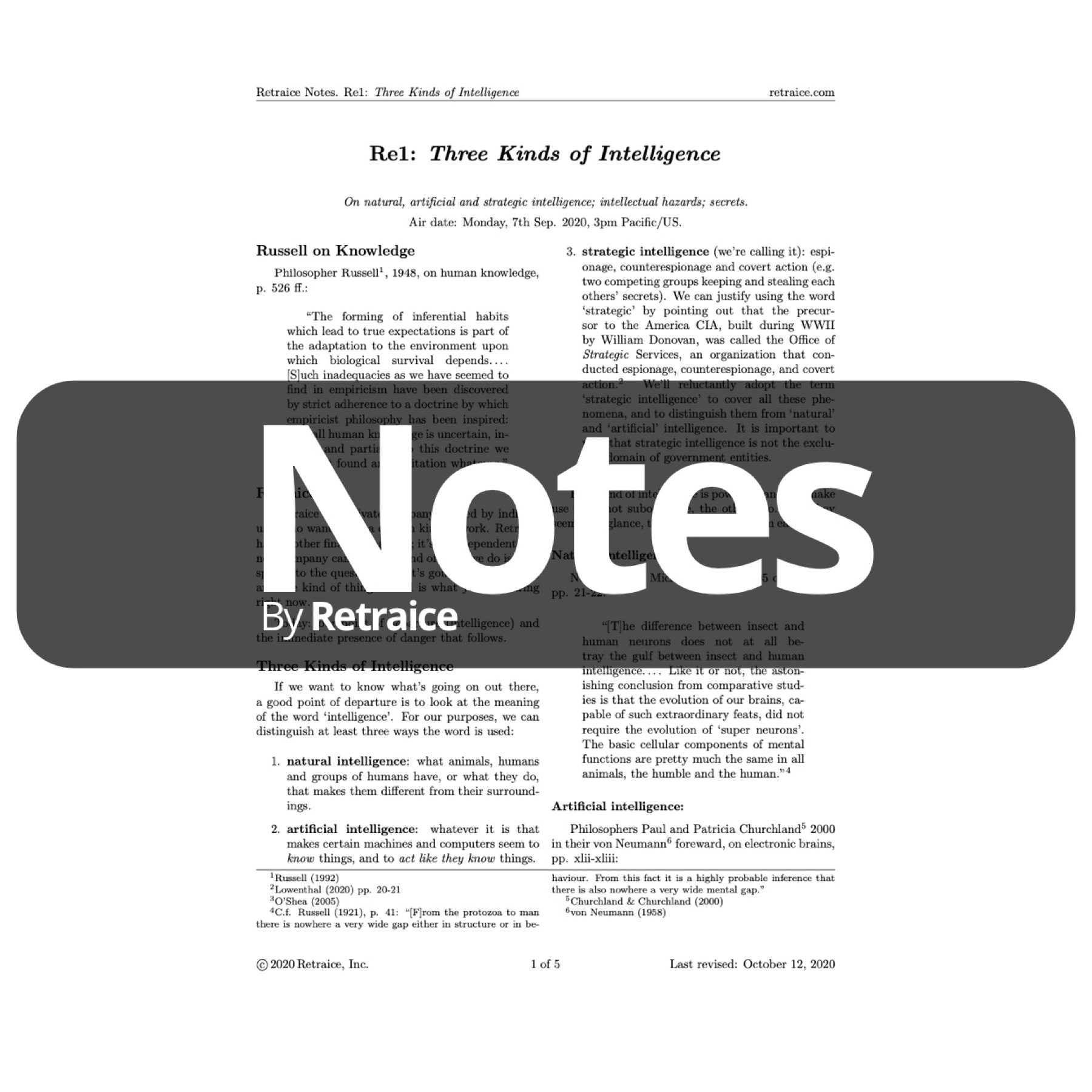(The below text version of the notes is for search purposes and convenience. See the PDF version for proper formatting such as bold, italics, etc., and graphics where applicable. Copyright: 2023 Retraice, Inc.)
Re104: Agent Functions, Agent Programs, Task Environments
(Day 2, AIMA4e Chpt. 2)
retraice.com
Correcting the TABLE-DRIVEN-AGENT series and modeling agents and environments.
Agent functions (math) and agent programs (code); task environments as problems, agents as solutions; labeling artifacts as agents or not; the most interesting artifacts; the PEAS-OADESDU model of task environments; locating the performance measure; utility functions; software agents and their sensors and actuators; the relevant parts of the universe; AI literacy (autoracy?) vs. literacy, numeracy, coding literacy (coderacy?).
Air date: Monday, 2nd Jan. 2023, 2:00 PM Eastern/US.
Correction to Re65-Re69, Re77 (Table-Driven-Agent series): agent program vs. agent function
*CORRECTION*: The `agent function' is not `the smart part' of the agent program. "The agent function is an abstract mathematical description.... that maps any percept sequence to an action"; "the agent program is a concrete implementation [of the agent function], running within some physical system." (100!black!//Russell & Norvig (2020) pp. 37-37) Function: math. Program: code. [Correction at Jan 2nd, 2023.]
Agents, task environments and their environments
Task environments are the "problems", agents are the "solutions".^1 Labeling entities as `agents' (as opposed to artifacts) is "a tool for analyzing systems, not an absolute characterization that divides the world into agents and non-agents.... AI operates at ...the most interesting end of the spectrum, where the artifacts have significant computational resources and the task environments require nontrivial decision making."^2
________________________________________________________________________________________________________________________________________________________________________________________________________________________________________________________________________________________________________________________________________________________________________________________________________________________________________________________________________________________________________________________________________________________________________________________________________________________________________________________________________________________________________________________________________________________________________________________________________________________________________________________________________________________________________________________________________________________________________________________________________________________________________
PIC
________________________________________________________________________________________________________________________________________________________________________________________________________________________________________________________________________________________________________________________________________________________________________________________________________________________________________________________________________________________________________________________________________________________________________________________________________________________________________________________________________________________________________________________________________________________________________________________________________________________________________________________________________________________________________________________________________________________________________________________________________________________________________
1.
Performance measure;^3
2.
Environment of the task environment:
(a)
Observability: fully, partially;
(b)
Agentness: single, multi;
(c)
Determinism: deterministic (current state plus action determines next state), stochastic (explicit probability numbers), nondeterministic (possibilities listed but no probability numbers);
(d)
Episodism: sequential, episodic;
(e)
Staticity: static, semi-static, dynamic;
(f)
Discreteness: discrete, continuous;
(g)
Unknownness: known, unknown (the agent's or designer's knowledge, arguably itself a part of the environment,^4 of the `laws of physics' of the environment).
3.
Actuators;
4.
Sensors.
The sensory inputs of software agents are file contents, network packets and human input via mouse, keyboard, etc. Software agents act on the environment by writing files, sending packets, and displaying information or making sounds.^5
The `environment' can in principle be the whole universe, but in practice its only "the part that affects what the agent perceives and that is affected by the agent's actions."^6
AI is a new kind of literacy
Our descendents, if we're lucky enough to have them, will think about the world in AI terms (PEAS and OADESDU descriptions of environments and agents, formalization of problems, agent functions and agent programs) just as we think about the world in letter (a, b, c), number (0, 1, 2) and code (function, variable, object) terms today.
_
References
Russell, S., & Norvig, P. (2020). Artificial Intelligence: A Modern Approach. Pearson, 4th ed. ISBN: 978-0134610993. Searches:
https://www.amazon.com/s?k=978-0134610993
https://www.google.com/search?q=isbn+978-0134610993
https://lccn.loc.gov/2019047498
Footnotes
^1 Russell & Norvig (2020) pp. 42-47.
^2 Russell & Norvig (2020) p. 38.
^3 On the best location to `draw' the performance measure, Russell & Norvig (2020) p. 54 say this: "We have already seen that a performance measure assigns a score to any given sequence of environment states, so it can easily distinguish between more and less desirable ways of getting to the taxi's destination. An agent's utility function is essentially an internalization of the performance measure. Provided that the internal utility function and the external performance measure are in agreement, an agent that chooses actions to maximize its utility will be rational according to the external performance measure."
^4 Cf. Russell & Norvig (2020) p. 46.
^5 Russell & Norvig (2020) p. 36.
^6 Russell & Norvig (2020) p. 36.

